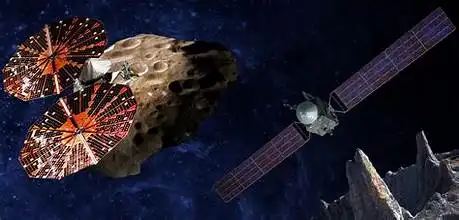NASA Embarks on Mission to Explore Psyche, a Metal-Rich Asteroid
<p>In an exciting and groundbreaking development, NASA initiated a mission from Florida to explore Psyche, the largest metal-rich asteroid known in our solar system. Scientists believe this asteroid may be the core of an ancient protoplanet, offering valuable insights into Earth’s formation. The launch took place at NASA’s Kennedy Space Center in Cape Canaveral, with […]</p>

NASA Embarks on Mission to Explore Psyche, a Metal-Rich Asteroid
In an exciting and groundbreaking development, NASA initiated a mission from Florida to explore Psyche, the largest metal-rich asteroid known in our solar system. Scientists believe this asteroid may be the core of an ancient protoplanet, offering valuable insights into Earth’s formation.
The launch took place at NASA’s Kennedy Space Center in Cape Canaveral, with the Psyche probe nestled safely inside a SpaceX Falcon Heavy rocket. As it soared through the partly cloudy skies, it marked the beginning of a planned 2.2 billion-mile journey through space, with the spacecraft, roughly the size of a small van, expected to reach the asteroid in August 2029.
The live broadcast of the launch on NASA TV was a captivating moment, representing NASA’s ongoing efforts to unravel the mysteries of our planet’s origins, dating back approximately 4.5 billion years.
This quest involves deploying robotic spacecraft to explore asteroids, which are primordial remnants from the early days of the solar system. Psyche, the target of this mission, boasts an impressive size, measuring approximately 173 miles across at its widest point. It resides on the outer fringes of the main asteroid belt, nestled between the planets Mars and Jupiter.
Shortly after launch, cargo-faring panels enclosing the spacecraft were jettisoned from the rocket’s upper stage. About an hour later, the probe itself was released into space. NASA has revealed that it takes approximately two hours for the spacecraft to autonomously unfurl its twin solar panels and align its communication antennae toward Earth.
Mission controllers at NASA’s Jet Propulsion Laboratory (JPL), located near Los Angeles, confirmed the detection of the probe’s first radio signals. The JPL team is prepared to spend the next three to four months conducting system checks before the spacecraft embarks on its deep space journey. This remarkable journey will be propelled by solar-electric ion thrusters, a groundbreaking technology used for the first time in an interplanetary mission.
Upon reaching the asteroid, the spacecraft will embark on a 26-month mission, during which it will scan Psyche using instruments specifically designed to measure its gravity, magnetic properties, and composition.
The leading hypothesis suggests that the asteroid is the once-molten, long-frozen inner core of a protoplanet that was torn apart by celestial collisions during the early days of the solar system. Interestingly, Psyche orbits the sun about three times farther from Earth, even at its closest approach.
Although Psyche is believed to consist mainly of iron, nickel, gold, and other precious metals, it’s important to clarify that the mission is not related to space mining. Instead, its primary objective is to enhance our understanding of the formation of Earth and other rocky planets, all of which have cores composed of molten metal. Given that Earth’s molten core is too deep and hot to explore directly, this mission serves as a remarkable endeavor to delve into “inner space.”
Lindy Elkins-Tanton, Psyche’s principal investigator for NASA’s mission partner, Arizona State University, humorously expressed the mission’s aim as “going to outer space to explore inner space” during a recent briefing for reporters.
Upon reaching Psyche, the probe will execute a series of gradually descending orbits, ultimately approaching within a mere 40 miles of the asteroid’s surface. The mission is expected to conclude in November 2031.
Psyche, discovered in 1852 and named after the goddess of the soul in Greek mythology, stands as the largest among about nine known asteroids that, based on ground-based radar observations, appear to be predominantly composed of metal, with some rocky material mixed in. Despite our knowledge, scientists can only speculate about Psyche’s actual appearance.
The spacecraft has been programmed to approach Mars in May 2026 for a gravity assist, which will boost its momentum and set it on the right trajectory for its final destination.
This mission brings several milestones on its path, including a technology demonstration designed to test a laser-based communication system. This system will transmit high-bandwidth data to Earth from beyond the moon, marking the first time such a feat has been achieved.
Moreover, this launch marks NASA’s first dedicated mission aboard a Falcon Heavy rocket, provided by Elon Musk’s SpaceX. It also represents the first interplanetary mission flown by the Falcon Heavy.
This launch occurred just two weeks after NASA successfully brought back the largest sample of material ever collected from an asteroid’s surface, specifically from the rocky near-Earth asteroid Bennu.
In 2021, NASA launched the Lucy spacecraft on a 12-year expedition to study the Trojan asteroids, which are two large clusters of space rocks orbiting the sun ahead of and behind Jupiter’s path. Additionally, last September, NASA executed a remarkable feat by altering the trajectory of an asteroid through a controlled impact—a testament to humanity’s evolving ability to defend our planet from celestial threats.








